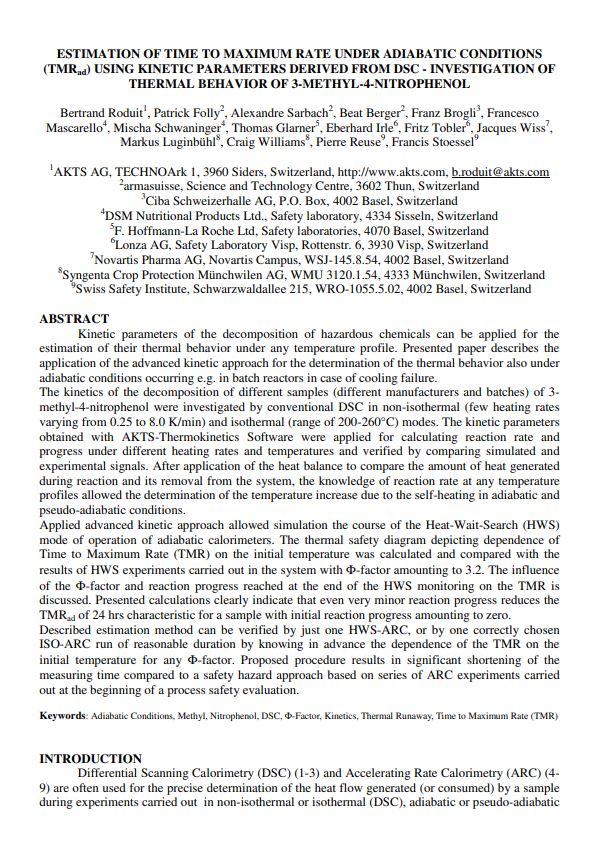B. Roduit1*, P. Folly2, A. Sarbach2, B. Berger2, F. Brogli3, F. Mascarello4, M. Schwaninger4, T. Glarner5, E. Irle6, F. Tobler6, J. Wiss7, M. Luginbühl8, C. Williams8, P. Reuse2, F. Stoessel9
+ More information
2armasuisse, Science and Technology Centre, 3602 Thun, Switzerland
3Ciba Schweizerhalle AG, P.O. Box, 4002 Basel, Switzerland
4DSM Nutritional Products Ltd., Safety laboratory, 4334 Sisseln, Switzerland
5F. Hoffmann-La Roche Ltd, Safety laboratories, 4070 Basel, Switzerland
6Lonza AG, Safety Laboratory Visp, Rottenstr. 6, 3930 Visp, Switzerland
7Novartis Pharma AG, Novartis Campus, WSJ-145.8.54, 4002 Basel, Switzerland
8Syngenta Crop Protection Münchwilen AG, WMU 3120.1.54, 4333 Münchwilen, Switzerland
9Swiss Safety Institute, Schwarzwaldallee 215, WRO-1055.5.02, 4002 Basel, Switzerland
* Author to whom correspondence should be addressed
Abstract
Kinetic parameters of the decomposition of hazardous chemicals can be applied for the estimation of their thermal behavior under any temperature profile. Presented paper describes the application of the advanced kinetic approach for the determination of the thermal behavior also under adiabatic conditions occurring e.g. in batch reactors in case of cooling failure. The kinetics of the decomposition of different samples (different manufacturers and batches) of 3-methyl-4-nitrophenol were investigated by conventional DSC in non-isothermal (few heating rates varying from 0.25 to 8.0 K/min) and isothermal (range of 200-260°C) modes. The kinetic parameters obtained with AKTS-Thermokinetics Software were applied for calculating reaction rate and progress under different heating rates and temperatures and verified by comparing simulated and experimental signals. After application of the heat balance to compare the amount of heat generated during reaction and its removal from the system, the knowledge of reaction rate at any temperature profiles allowed the determination of the temperature increase due to the self-heating in adiabatic and pseudo-adiabatic conditions.
Applied advanced kinetic approach allowed simulation the course of the Heat-Wait-Search (HWS) mode of operation of adiabatic calorimeters. The thermal safety diagram depicting dependence of Time to Maximum Rate (TMR) on the initial temperature was calculated and compared with the results of HWS experiments carried out in the system with F-factor amounting to 3.2. The influence of the F-factor and reaction progress reached at the end of the HWS monitoring on the TMR is discussed. Presented calculations clearly indicate that even very minor reaction progress reduces the TMRad of 24 hrs characteristic for a sample with initial reaction progress amounting to zero.
Described estimation method can be verified by just one HWS-ARC, or by one correctly chosen ISO-ARC run of reasonable duration by knowing in advance the dependence of the TMR on the initial temperature for any F-factor. Proposed procedure results in significant shortening of the measuring time compared to a safety hazard approach based on series of ARC experiments carried out at the beginning of a process safety evaluation.














